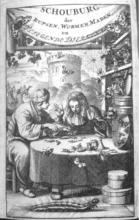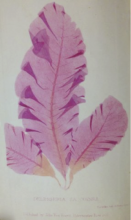The Alice Eve Kennington Rare Book Endowment
 |
| Blankaart, Steven. Schou-burg der rupsen, wormen, ma’den… Amsterdam, 1688. Engraved title page. |
The Alice Eve Kennington Rare Book Endowment was established in 2000 by Dr. Ellinor Michel to honor her mother, Alice Kennington. The endowment funds the acquisition and preservation of Natural History rare books.
 |
|
Cocks, John. The sea-weed collector’s guide. London, 1853. Title page and frontispiece. |
The Kennington Endowment funds are used primarily to purchase rare books in two specific subject areas: instructions for collecting and preparing natural-history specimens prior to 1900, and auction and exhibition catalogs for natural-history collections and the libraries of naturalists, prior to 1900. In both cases, the Libraries are building on donations of publications from the Natural History Museum’s scientists themselves, most notably Alexander Wetmore (1886-1978), an ornithologist and Secretary of the Institution, and Charles W. Richmond (1868-1932), a bibliographer in the Birds Division.
These books support the Natural History Museum by providing staff with information about the chemicals used to preserve older specimens and by helping researchers track important collections and specimens from their original owners, as recorded in the early literature, to their modern-day locations, where they can be examined anew.
The Alice Eve Kennington Rare Book Endowment has made it possible to acquire a fascinating variety of such materials, from directions for collecting insects, sea-weed, and birds’ eggs that range in date from 1668 to the 1890s, to the catalog of an exhibition in Paris in the 1880s describing an archaeological collection from Mexico that is directly tied to the current research of a curator in the Anthropology Department. Given the nature and obscurity of these publications – small, flimsy, and often worn out – they tend to be fairly scarce in U.S. libraries, and for at least one of the auction catalogs, the Smithsonian Libraries are now the proud care-takers of the only known surviving copy.
